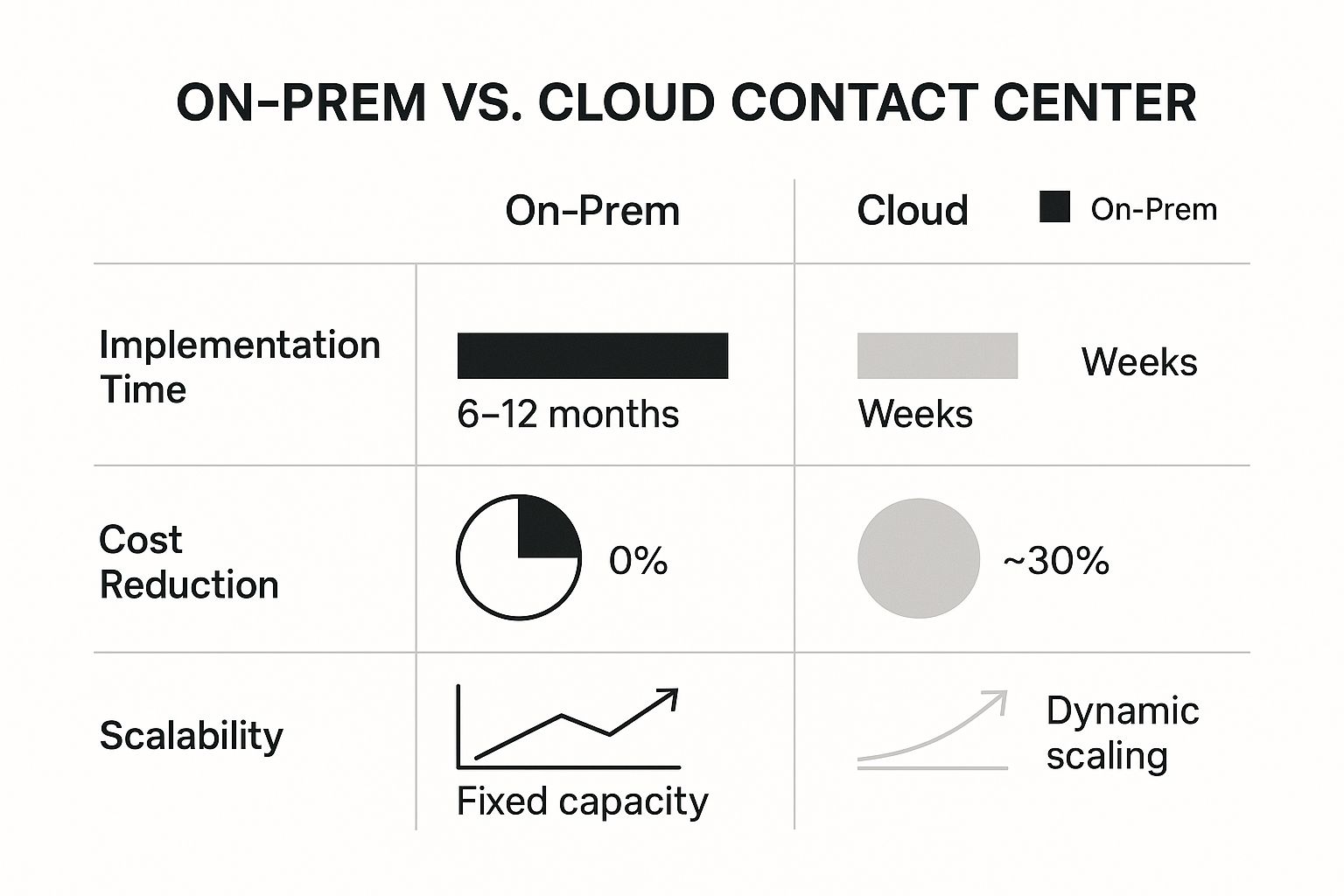The Middle East's Cloud Contact Center Evolution

Customer service is a critical aspect of the changing business landscape in the Middle East. Traditional call centers, with their inflexible infrastructure and limitations, are struggling to adapt. This has created an opportunity for cloud contact centers, offering a more flexible, scalable, and cost-effective way to engage with customers. This shift represents a significant change in how businesses in the region interact with their customers.
Key Drivers of Change
Several factors contribute to the increasing adoption of cloud contact centers in the Middle East. The region's mobile-first approach requires solutions that integrate smoothly with smartphones and messaging applications. The diverse range of languages spoken necessitates multilingual support, a feature easily accommodated by cloud platforms. The growing e-commerce sector also fuels the demand for more robust and scalable customer service.
Market Growth and Regional Impact
The cloud contact center market in the Middle East and Africa is experiencing remarkable growth. Currently valued at USD 1.56 billion in 2024, the market is projected to reach USD 7.96 billion by 2033, with a CAGR of 19.85%. This expansion highlights the region's rapid adoption of cloud communication tools. You can find more details on this market growth at Market Data Forecast. This impressive growth is driven by the desire for better customer experiences, lower operational costs, and increased scalability, particularly within the expanding e-commerce sector. While some government bodies have raised concerns about potential job displacement overseas, businesses prioritize cost-effectiveness. They often choose cloud models that can access a global talent pool while adhering to local regulations.
Comparing Traditional and Cloud Solutions
The following data chart illustrates the projected growth of the cloud contact center market in the MEA region from 2024 to 2033.
[Infographic will be placed here]
- 2024: USD 1.56 Billion
- 2025: Projected value reflecting the start of the 19.85% CAGR
- 2026 – 2032: Intermediate growth points showcasing the year-on-year increase
- 2033: USD 7.96 Billion
The chart clearly shows a steep upward trend, indicating significant investment and growth potential within this sector.
To further understand the differences, the following table summarizes the key distinctions between traditional and cloud contact centers and their regional impact in the Middle East:
To better compare the two options, let's look at the key differences between traditional and cloud-based contact centers in the Middle East. The following table provides a detailed comparison:
| Feature | Traditional Contact Center | Cloud Contact Center | Regional Impact |
|---|---|---|---|
| Scalability | Limited and expensive | Highly scalable and flexible | Adapts to seasonal peaks like Ramadan |
| Cost | High upfront investment and ongoing maintenance | Subscription-based, predictable operating expenses | Reduces capital expenditure, attractive to SMEs |
| Multilingual Support | Complex and costly to implement | Easily integrates multiple languages | Caters to the diverse linguistic needs of the region |
| Mobile Integration | Often limited | Seamless mobile integration | Aligns with the region's mobile-first culture |
| Data Security | Concerns about on-site security breaches | Robust security measures in the cloud | Addresses regional concerns regarding data safety |
This transition to cloud contact centers marks a significant change for businesses in the Middle East. It allows them to not only enhance their customer service but also adapt to the evolving regional market. This positions them for continued growth and success.
Transforming Regional Business Through Cloud Contact Centers

The growing popularity of cloud contact centers in the Gulf region isn't just about technological progress. It's significantly driven by the measurable return on investment (ROI) these systems deliver. This shift is reshaping how businesses in the region operate and engage with their customers.
Understanding the ROI of Cloud Contact Centers
Many regional Chief Information Officers (CIOs) and service leaders cite financial benefits as a key reason for adopting cloud contact centers. The subscription-based model of cloud services, for instance, transforms unpredictable capital expenditures into predictable operational costs. This provides better budget control and stability, a significant advantage in uncertain economic times.
The flexibility of cloud technology also aligns well with the increasingly mobile workforce in the region. This allows businesses to maintain operations during unexpected events, like the pandemic. It also allows them to scale services to meet changing demands, such as during Ramadan. This scalability is a major benefit for rapidly growing businesses.
To illustrate the financial and operational improvements observed in Middle Eastern businesses after implementing cloud contact centers, we've compiled the following data:
The table below provides a snapshot of ROI metrics observed across different business sizes and implementation timelines. It showcases the potential for cost reduction, customer satisfaction improvement, and agent productivity increase.
Cloud Contact Center ROI Metrics for MEA Businesses:
| Business Size | Implementation Timeline | Cost Reduction (%) | Customer Satisfaction Improvement | Agent Productivity Increase |
|---|---|---|---|---|
| SME | 6 Months | 15 | 12 | 10 |
| Mid-Market | 9 Months | 22 | 18 | 15 |
| Enterprise | 12 Months | 30 | 25 | 20 |
As the table demonstrates, organizations of all sizes have realized significant gains across key performance indicators. The longer implementation timelines for larger businesses reflect the greater complexity of integrating these systems into existing infrastructure, but the resulting ROI is often proportionally higher.
Real-World Success Stories in the AE Region
Businesses across various sectors in the AE region are seeing tangible benefits from cloud contact center implementations. Success stories span retail, banking, and government. In retail, improved customer interactions and personalized service lead to higher sales.
For banking, enhanced security and streamlined communication build trust and improve customer loyalty. Government agencies benefit from better citizen engagement and more effective service delivery.
Key Benefits for Businesses
Cloud contact centers offer several advantages for businesses in the AE region. Some key benefits include:
- Cost Savings: Reduced capital expenditure and predictable operational expenses.
- Scalability: Easily adjust resources to meet changing demands.
- Mobility: Support a remote or hybrid workforce.
- Business Continuity: Maintain operations during unexpected disruptions.
- Improved Customer Experience: Personalized, omnichannel support.
Focusing on the Future
The move towards cloud contact centers is a strategic investment for businesses in the AE region. It enables them to improve customer service, streamline operations, and gain a competitive edge. The cloud will continue to shape the future of customer interaction in the Middle East.
For companies looking to improve customer engagement and optimize operations, exploring a solution like Cloud Move can be a strategic step towards success.
CCaaS: The Game-Changer for Middle Eastern Customer Service

While the general benefits of cloud contact centers are numerous, let's explore the specific advantages of Contact Center as a Service (CCaaS). This model is quickly reshaping customer service in the Middle East, providing a flexible and affordable solution for businesses of all sizes.
Accessibility and Adaptability of CCaaS
Unlike traditional systems with high upfront costs, CCaaS utilizes a subscription-based model. This democratizes access to advanced customer service technology, enabling smaller businesses in the region to compete effectively with larger enterprises. This accessibility is vital for a healthy and competitive market.
CCaaS also offers unparalleled adaptability, a key advantage in the Middle East's ever-changing business environment. Companies can easily scale their services up or down to meet fluctuating demands, like those experienced during Ramadan or other major shopping periods. This agility is impossible with older, legacy systems.
Multilingual Support and Regional Integration
CCaaS platforms excel at simultaneous multilingual support. This is essential in the Middle East, a region where Arabic, English, and various local languages are prevalent. This feature enables businesses to connect with a broader customer base, providing personalized service in each customer's preferred language. Furthermore, CCaaS platforms often integrate with popular regional messaging apps like WhatsApp, strengthening customer engagement.
This integration extends to widely used CRM systems such as Salesforce and Microsoft Dynamics 365, offering a comprehensive view of customer interactions and data. This is a substantial improvement over traditional systems, where data is often isolated, hindering communication and personalized service.
AI-Powered Routing and Cultural Understanding
Modern CCaaS solutions often feature AI-powered routing. This technology directs customers to the most appropriate agents based on a variety of criteria. This goes beyond simple language matching; it considers the customer’s specific issue, the agent's expertise, and even cultural sensitivities.
This emphasis on cultural awareness is especially critical in the Middle East. Customer expectations and preferred communication styles can differ substantially across the region. By recognizing these nuances, businesses can craft personalized experiences that resonate with local customs, leading to increased customer satisfaction and loyalty.
The Middle East Contact Center as a Service (CCaaS) market is predicted to reach USD 1,122.9 million by 2032, with a 12.9% CAGR. This impressive growth is driven by increased adoption of omnichannel engagement tools, AI chatbots, and real-time analytics. These technologies streamline workflows and enhance regulatory compliance. More detailed statistics can be found at Fortune Business Insights. This expanding market clearly reflects the growing need for sophisticated customer service solutions in the region.
From Selection to Success: Implementing Your Cloud Contact Center
Transitioning to a cloud contact center is a significant undertaking. This section offers practical guidance for organizations in the Middle East, navigating the key implementation steps. This journey covers everything from vendor selection to ensuring a smooth transition for your team.
Choosing the Right Cloud Contact Center Vendor
Selecting a vendor is the first, and most crucial, step. The right partner understands the specific needs of the Middle Eastern market.
Key considerations include:
- Arabic Language Support: Ensure the platform offers full Arabic language capabilities, including right-to-left text and dialect variations.
- Regional Data Sovereignty: Compliance with local data laws is paramount. Choose a vendor offering data storage within the AE region.
- Integration with Local Systems: Seamless integration with existing systems, such as local payment gateways and CRM platforms, is vital for operational efficiency.
- Cultural Understanding: Select a vendor demonstrating a deep understanding of the region's cultural nuances, which directly impact customer service expectations.
Planning Your Migration Timeline
After selecting a vendor, develop a realistic implementation timeline. This plan should outline key milestones, including data migration, system integration, and staff training. A phased approach can minimize disruption and allow for adjustments.
For example, migrating one department at a time to the cloud contact center allows you to identify and address potential issues before a full-scale launch.
Managing the Cultural Shift
Implementing a cloud contact center often involves a cultural shift within an organization. This requires careful change management. Clear communication and staff involvement are crucial for smooth transitions.
Providing adequate training and support empowers employees to embrace the new technology. This support should cover both technical skills and an understanding of how the system aligns with regional customer expectations.
Integrating with Region-Specific Systems
Integrating your cloud contact center with region-specific systems is vital for efficient operations. Connecting to local payment gateways is essential for handling local currency transactions.
This integration also extends to popular messaging platforms like WhatsApp, widely used in the Middle East for customer communication. Compatibility with these regional platforms is key to providing seamless customer service.
Navigating Regional Challenges
Region-specific challenges can arise during implementation. Connectivity in certain areas may require careful planning to ensure consistent service. Data sovereignty laws also vary across the region, necessitating adherence to local regulations.
However, with proper planning and vendor collaboration, these challenges are manageable. Choosing a vendor with local expertise simplifies this process considerably.
Training Staff for Success
Effective staff training is paramount for maximizing the benefits of your cloud contact center. Training should encompass both the technical aspects of the platform and cultural sensitivity.
Delivering training in multiple languages caters to the region's diverse workforce. This ensures all staff understand the platform's functionalities and how to use them effectively.
Realistic Timelines and Potential Pitfalls
Cloud contact center implementations typically take several months. Smaller deployments can be faster, but larger, more complex projects require more time. Understanding realistic timelines helps avoid unrealistic expectations.
Potential pitfalls include inadequate planning, insufficient training, and unforeseen technical issues. Thorough planning and collaboration with experienced implementation partners can mitigate these risks.
Proven Strategies for Regional Success
Companies across the Middle East have successfully implemented cloud contact centers. Their successes highlight proven strategies:
- Partnering with Local Experts: Working with vendors who understand the local market ensures alignment with regional needs.
- Prioritizing Arabic Language Support: Implementing comprehensive Arabic language features improves the customer experience.
- Focusing on Data Security and Compliance: Adhering to local data regulations builds customer trust.
- Investing in Staff Training: Thorough training empowers staff to fully utilize the platform.
By implementing these strategies, businesses can realize the full potential of cloud contact centers and transform their customer service in the AE region. If you're considering this switch, exploring a provider like Cloud Move is a valuable first step. They offer tailored solutions designed for the Middle East.
Navigating Cloud Contact Centers Across Diverse MEA Markets

The Middle East and Africa (MEA) region presents unique challenges for businesses implementing cloud contact centers. The diverse economies, cultures, and levels of technological infrastructure mean a standardized approach is ineffective. Companies must carefully tailor their strategies to each market's specific needs.
Tailoring Strategies for GCC Markets
Gulf Cooperation Council (GCC) countries, particularly the UAE and Saudi Arabia, often prioritize high-touch, personalized customer experiences. High customer expectations and a demand for premium service are hallmarks of these markets. This translates into a need for advanced cloud contact center features.
For example, AI-powered chatbots and personalized Arabic greetings contribute to a more tailored experience. Sentiment analysis tools, like those offered by Amazon Web Services, can also help identify and address customer concerns, boosting satisfaction.
Cost-Effective Solutions for North African Markets
North African markets, in contrast, often prioritize cost-efficiency and scalability. Cloud contact centers offer a compelling solution by providing access to advanced technology without significant upfront investment. This democratizes access to sophisticated customer service tools.
This is especially beneficial for smaller businesses competing with larger enterprises. The ability to scale services up or down offers flexibility in these dynamic markets, allowing businesses to respond effectively to fluctuating conditions and customer demands.
Infrastructure and Talent Availability
Telecommunications infrastructure and the availability of skilled talent are key factors influencing cloud contact center strategies. While GCC countries generally boast robust infrastructure, facilitating the seamless integration of advanced cloud solutions, some North African regions may experience connectivity issues.
These differences highlight the need for a cloud contact center provider with a strong regional presence and specialized knowledge. Providers like Cloud Move, with established partnerships across the AE region, are well-positioned to address these infrastructural variations.
Localization Beyond Translation
Successful implementation demands a nuanced approach to localization. This extends beyond mere translation into Arabic or other local languages. Understanding the cultural nuances that affect customer service expectations is paramount.
Personalized greetings and using appropriate titles are essential for building rapport. This necessitates a deep understanding of local customs. In some cultures, customers prefer interacting with agents who share their language or background. These considerations should inform staffing and training decisions.
The Rest of MEA call center market (excluding major Gulf economies) is expected to grow at an 11.2% CAGR, reaching USD 744.54 million by 2025. While this includes traditional call centers, cloud migration is transforming the sector, particularly in cost-conscious African markets. Learn more about this market growth here. Expanding cloud infrastructure, including carbon-neutral data centers, further supports this trend. This growth is particularly important for industries like telecommunications and banking, which rely on scalable and secure customer service platforms.
Frameworks for Regional Expansion
Businesses expanding their contact center operations across MEA markets need a structured approach. This framework should encompass:
- Market Research: A thorough understanding of each target market's unique characteristics is essential.
- Vendor Selection: Choosing a provider with regional expertise and strong local partnerships is critical.
- Localization Strategy: A culturally sensitive approach to customer interactions is crucial.
- Scalability Plan: The chosen solution must be able to adapt to changing demands.
- Training and Support: Local teams need adequate training and resources.
By adopting this tailored strategy, businesses can maximize the benefits of cloud contact centers across the diverse MEA markets. This ensures customer service operations align with local needs and expectations, fostering growth and strengthening customer relationships. For businesses in the AE region, considering a provider like Cloud Move, with its focus on customization and local expertise, is a valuable step toward success.
The Future of Middle Eastern Cloud Contact Centers
The Middle East is quickly becoming a hub for technological advancement, with cloud contact centers leading the charge. This growth is fueled by a combination of factors, including substantial regional investment in new technologies and evolving customer expectations. This creates a dynamic environment for businesses to refine how they connect with their clientele.
AI-Powered Personalization in Arabic and Regional Languages
Artificial intelligence (AI) is transforming customer service in the Middle East. Developers are optimizing AI for Arabic dialects and other regional languages, moving beyond simple translation to grasp the nuances of local communication. This sophisticated approach enhances sentiment analysis, enabling cloud contact centers to assess customer emotions more accurately and understand cultural contexts beyond the words themselves.
For instance, an AI trained on regional data can distinguish between polite formality and genuine enthusiasm, empowering businesses to tailor their responses appropriately. This personalized approach fosters more authentic and meaningful customer interactions.
Building Stronger Relationships With Video and Voice
Relationships are paramount in Middle Eastern business culture. Progressive organizations are embracing this by implementing video-based customer service. This face-to-face approach cultivates trust and reinforces the customer-business bond, aligning seamlessly with regional values.
Furthermore, voice biometrics is gaining traction as a secure and convenient identification method. This technology addresses local privacy concerns by eliminating the need for customers to repeatedly share personal information. This emphasis on personalized security is especially relevant in today's data-sensitive world.
5G and the Rise of Mobile-First Experiences
The ambitious rollout of 5G across the Middle East promises a new era of mobile-first customer experiences. Cloud contact centers will be able to deliver richer, more interactive services on mobile devices, integrating smoothly with existing apps and social media platforms like Facebook. This improved connectivity will create more dynamic and personalized customer journeys.
Imagine resolving a complex issue through a real-time video chat with a support agent, all within your banking app—this is the future that 5G is enabling. These advancements are also making interactions significantly more convenient for customers.
Sustainability and the Cloud
Regional sustainability initiatives are shaping decisions around cloud infrastructure. Businesses are opting for providers who prioritize environmental responsibility. This translates to data centers powering cloud contact centers increasingly relying on renewable energy sources and implementing energy-efficient technologies.
This focus on sustainability echoes the region's growing commitment to a greener future. This commitment not only benefits the environment but also resonates with environmentally conscious customers.
The future of Middle Eastern cloud contact centers is bright, propelled by a dedication to innovation and a deep understanding of regional requirements. This ongoing evolution will continue to reshape customer experiences, fostering stronger relationships and more efficient interactions. For businesses in the AE region seeking a forward-looking customer service solution, Cloud Move offers customized deployments tailored to local needs and expectations. Contact us for a free demo and consultation.
Article created using Outrank




